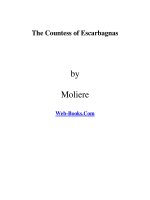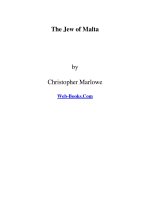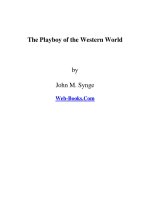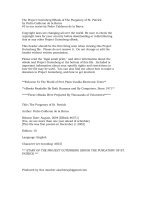The Purgatory of St. Patrick
Bạn đang xem bản rút gọn của tài liệu. Xem và tải ngay bản đầy đủ của tài liệu tại đây (98.48 KB, 11 trang )
The Project Gutenberg EBook of The Purgatory of St. Patrick
by Pedro Calderon de la Barca
#3 in our series by Pedro Calderon de la Barca
Copyright laws are changing all over the world. Be sure to check the
copyright laws for your country before downloading or redistributing
this or any other Project Gutenberg eBook.
This header should be the first thing seen when viewing this Project
Gutenberg file. Please do not remove it. Do not change or edit the
header without written permission.
Please read the "legal small print," and other information about the
eBook and Project Gutenberg at the bottom of this file. Included is
important information about your specific rights and restrictions in
how the file may be used. You can also find out about how to make a
donation to Project Gutenberg, and how to get involved.
**Welcome To The World of Free Plain Vanilla Electronic Texts**
**eBooks Readable By Both Humans and By Computers, Since 1971**
*****These eBooks Were Prepared By Thousands of Volunteers!*****
Title: The Purgatory of St. Patrick
Author: Pedro Calderon de la Barca
Release Date: August, 2004 [EBook #6371]
[Yes, we are more than one year ahead of schedule]
[This file was first posted on December 2, 2002]
Edition: 10
Language: English
Character set encoding: ASCII
*** START OF THE PROJECT GUTENBERG EBOOK THE PURGATORY OF ST.
PATRICK ***
Produced by Sue Asscher
CALDERON'S DRAMAS.
THE PURGATORY OF ST. PATRICK.
NOW FIRST TRANSLATED FULLY FROM THE SPANISH IN THE METRE
OF THE ORIGINAL.
BY
DENIS FLORENCE MAC-CARTHY.
LONDON: HENRY S. KING & CO.,
65 CORNHILL, AND 12, PATERNOSTER ROW.
1873.
INTRODUCTION.
Two of the dramas contained in this volume are the most celebrated of
all Calderon's writings. The first, "La Vida es Sueno", has been
translated into many languages and performed with success on almost
every stage in Europe but that of England. So late as the winter of
1866-7, in a Russian version, it drew crowded houses to the great
theatre of Moscow; while a few years earlier, as if to give a signal
proof of the reality of its title, and that Life was indeed a Dream,
the Queen of Sweden expired in the theatre of Stockholm during the
performance of "La Vida es Sueno". In England the play has been much
studied for its literary value and the exceeding beauty and lyrical
sweetness of some passages; but with the exception of a version by
John Oxenford published in "The Monthly Magazine" for 1842, which
being in blank verse does not represent the form of the original, no
complete translation into English has been attempted. Some scenes
translated with considerable elegance in the metre of the original
were published by Archbishop Trench in 1856; but these comprised only
a portion of the graver division of the drama. The present version
of the entire play has been made with the advantages which the
author's long experience in the study and interpretation of Calderon
has enabled him to apply to this master-piece of the great Spanish
poet. All the forms of verse have been preserved; while the
closeness of the translation may be inferred from the fact, that not
only the whole play but every speech and fragment of a speech are
represented in English in the exact number of lines of the original,
without the sacrifice, it is to be hoped, of one important idea.
A note by Hartzenbusch in the last edition of the drama published at
Madrid (1872), tells that "La Vida es Sueno", is founded on a story
which turns out to be substantially the same as that with which
English students are familiar as the foundation of the famous
Induction to the "Taming of the Shrew". Calderon found it however in
a different work from that in which Shakespeare met with it, or
rather his predecessor, the anonymous author of "The Taming of a
Shrew", whose work supplied to Shakespeare the materials of his own
comedy.
On this subject Malone thus writes. "The circumstance on which the
Induction to the anonymous play, as well as to the present Comedy
[Shakespeare's "Taming of the Shrew"], is founded, is related (as
Langbaine has observed) by Heuterus, "Rerum Burgund." lib. iv. The
earliest English original of this story in prose that I have met with
is the following, which is found in Goulart's "Admirable and
Memorable Histories", translated by E. Grimstone, quarto, 1607; but
this tale (which Goulart translated from Heuterus) had undoubtedly
appeared in English, in some other shape, before 1594:
"Philip called the good Duke of Burgundy, in the memory of our
ancestors, being at Bruxelles with his Court, and walking one night
after supper through the streets, accompanied by some of his
favourites, he found lying upon the stones a certaine artisan that
was very dronke, and that slept soundly. It pleased the prince in
this artisan to make trial of the vanity of our life, whereof he had
before discoursed with his familiar friends. He therefore caused
this sleeper to be taken up, and carried into his palace; he commands
him to be layed in one of the richest beds; a riche night cap to be
given him; his foule shirt to be taken off, and to have another put
on him of fine holland. When as this dronkard had digested his wine,
and began to awake, behold there comes about his bed Pages and
Groomes of the Duke's Chamber, who drawe the curteines, make many
courtesies, and being bare-headed, aske him if it please him to rise,
and what apparell it would please him to put on that day. They bring
him rich apparell. This new Monsieur amazed at such courtesie, and
doubting whether he dreamt or waked, suffered himselfe to be drest,
and led out of the chamber. There came noblemen which saluted him
with all honour, and conduct him to the Masse, where with great
ceremonie they give him the booke of the Gospell, and the Pixe to
kisse, as they did usually to the Duke. From the Masse they bring
him back unto the pallace; he washes his hands, and sittes down at
the table well furnished. After dinner, the Great Chamberlain
commands cards to be brought with a great summe of money. This Duke
in imagination playes with the chief of the Court. Then they carry
him to walke in the gardein, and to hunt the hare, and to hawke.
They bring him back into the pallace, where he sups in state.
Candles being light the musitions begin to play; and the tables taken
away, the gentlemen and gentlewomen fell to dancing. Then they
played a pleasant comedie, after which followed a Banket, whereat
they had presently store of Ipocras and pretious wine, with all sorts
of confitures, to this prince of the new impression; so as he was
dronke, and fell soundlie asleepe. Hereupon the Duke commanded that
he should be disrobed of all his riche attire. He was put into his
old ragges, and carried into the same place, where he had been found
the night before; where he spent that night. Being awake in the
morning, he began to remember what had happened before; he knewe not
whether it were true indeede, or a dream that had troubled his
braine. But in the end, after many discourses, he concludes that ALL
WAS BUT A DREAME that had happened unto him; and so entertained his
wife, his children, and his neighbours, without any other
apprehension."
It is curious to find that the same anecdote which formed the
Induction to the original "Taming of a Shrew", and which, from a
comic point of view, Shakespeare so wonderfully developed in his own
comedy, Calderon invested with such solemn and sublime dignity in "La
Vida es Sueno". He found it, as Senor Hartzenbusch points out in the
edition of 1872 already quoted, in the very amusing "Viage
Entretenido" of Augustin de Rojas, which was first published in 1603.
Hartzenbusch refers to the modern edition of Rojas, Madrid, 1793,
tomo I, pp. 261, 262, 263, but in a copy of the Lerida edition of
1615, in my own possession, I find the anecdote at folios 118, 119,
120. There are some slight differences between the version of Rojas
and that of Goulart, but the incidents and the persons are the same.
The conclusion to which the artizan arrived at, in the version of
Goulart, that all had been a dream, is expressed more strongly by the
Duke himself in the story as told by Rojas.
"Y dijo entonces el Duque: 'veis aqui, amigos, "Lo que es el Mundo:
Todo es un Sueno", pues esto verdaderamente ha pasado por este, como
habeis visto, y le parece que lo ha sonado.'" --
The story in all probability came originally from the East. Mr. Lane
in his translation of the Thousand and One Nights gives a very
interesting narrative which he believes to be founded on an
historical fact in which Haroun Al Raschid plays the part of the good
Duke of Burgundy, and Abu-l-Hasan the original of Christopher Sly.
The gravity of the treatment and certain incidents in this Oriental
story recall more strongly Calderon's drama than the Induction to the
"Taming of the Shrew". "La Vida es Sueno" was first published either
at the end of 1635 or beginning of 1636.
The "Aprobacion" for its publication along with eleven other dramas
(not nine as Archbishop Trench has stated), was signed on the 6th of
November in the former year by the official licenser, Juan Bautista
de Sossa. The volume was edited by the poet's brother, Don Joseph
Calderon. So scarce has this first authorised collection of any of
Calderon's dramas become, that a Spanish writer Don Vicente Garcia de
la Huerta, in his "Teatro Espanol" (Parte Segunda, tomo 3o), denies
the existence of this volume of 1635, and states that it did not
appear until 1640. As if to corroborate this view, Barrera in his
"Catalogo del Teatro antiguo Espanol" gives the date 1640 to the
"Primera parte de comedias de Calderon" edited by his brother Joseph.
There can be no doubt, however, that the volume appeared in 1635 or
1636 as stated. In 1637 Don Joseph Calderon published the "Second
Part" of his brother's dramas containing like the former volume
twelve plays.* In his dedication of this volume to D. Rodrigo de
Mendoza, Joseph Calderon expressly alludes to the First Part of his
brother's comedies which he had "printed." "En la primera Parte,
Excellentissimo Senor, de las comedias que imprimi de Don Pedro
Calderon de La Barca, mi hermano," etc. This of course settles the
fact of the prior publication of the first Part. It is singular,
however, to find that the most famous of all Calderon's dramas should
have been frequently ascribed to Lope de Vega. So late as 1857 it is
given in an Italian version by Giovanni La Cecilia, under the title
of "La Vita e un Sogno", as a drama of Lope de Vega, with the date
1628. This of course is a mistake, but Senor Hartzenbusch, who makes
no allusion to this circumstance, admits that two dramas of Lope de
Vega, which it is presumed preceded the composition of Calderon's
play turn on very nearly the same incidents as those of "La Vida es
Sueno". These are "Lo que ha de ser", and "Barlan y Josafa". He
gives a passage from each of these dramas which seem to be the germ
of the fine lament of Sigismund, which the reader will find
translated in the present volume.
[footnote] *In the library of the British Museum there is a fine copy
of this "Segunda Parte de Comedias de Don Pedro Calderon de la Barca"
Madrid, 1637. Mr. Ticknor mentions (1863) that he too had a copy of
this interesting volume.
Senor Hartzenbusch, in the edition of Calderon's "La Vida es Sueno",
already referred to (Madrid, 1872), prints the passages from Lope de
Vega's two dramas, but in neither of them, he justly remarks, can we
find anything that at all corresponds to this "grandioso caracter de
Segismundo."
The second drama in this volume, "The Wonderful Magician", is perhaps
better known to poetical students in England than even the first,
from the spirited fragment Shelley has left us in his "Scenes from
Calderon." The preoccupation of a subject by a great master throws
immense difficulties in the way of any one who ventures to follow in
the same path: but as Shelley allowed himself great licence in his
versification, and either from carelessness or an imperfect knowledge









